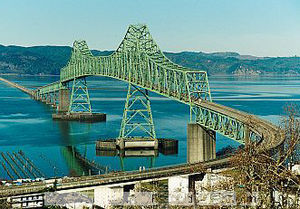Advertisement
Published: August 8th 2007

 The historic town of Astoria
The historic town of Astoria
Astoria offers more points of historical interst than any other city on the Oregon coast. The Astoria-Megler Bridge was built in 1966 and was the final link in the Mexico-to- Canada highway system. The bridge stretches 4.1 miles from Astoria, Oregon to Point Ellice, Washington, crossing at the mouth of the Columbia River. The main span of the bridge is 1232 feet, the longest “continuous truss” in the world. The views are beautiful and well worth the drive over and back.While others in the rest of the country are suffering from high heat, we are wearing coats and sweatshirts here in Oregon. Days average around 70 and nights are down around 50’s in temperature. The Oregonians say, if the sun is shining it will be windy, and they were not kidding! They are quite used to this weather and when the sun is out, they think it is summer! Most of the photos of us show us wearing heavy clothing while here the local people are wearing shorts and swimming in the ocean which is extremely cold.
The northern Oregon coast pulses with a rich and varied habitat. It draws people to its shores and along the many estuaries and rivers that knit their way through forests and fields to the surf, sand, and sea. The coastal communities also have an equally rich and diverse history that is steeped in maritime heritage, timber, and pioneer settlements. This heritage reaches back thousands of years to the Original People who first inhabited the shorelines.
The Lewis and Clark National Historic Park encompasses 12 smaller parks that lie within Oregon and Washington along a 40-mile section of the coast from Long Beach,
Washington to Cannon Beach, Oregon.
Astoria offers more points of historical interst than any other city on the Oregon coast.
The historic town of Astoria, located along the Columbia River spreads up and over San Francisco-like hills. In 1792, Robert Gray sailed his ship, The Columbia Rediviva, into the area and named the river “The Columbia”. The oldest settlement west of the Rockies, its history dates back to 1805 and it is located at the mouth of the great and mighty Columbia River. Astoria is a very historic site for many reasons. Lewis and Clarke ended their journey across the country on the Oregon trail here in Astoria.
The National Maritime Museum is here as well as many museums about the history of the area. There are many lighthouses along the coastline to protect sailors from the treacherous seas and gigantic rock cliffs .
Advertisement
Tot: 0.222s; Tpl: 0.017s; cc: 5; qc: 50; dbt: 0.0832s; 1; m:domysql w:travelblog (10.17.0.13); sld: 1;
; mem: 1.1mb

 The historic town of Astoria
The historic town of Astoria








